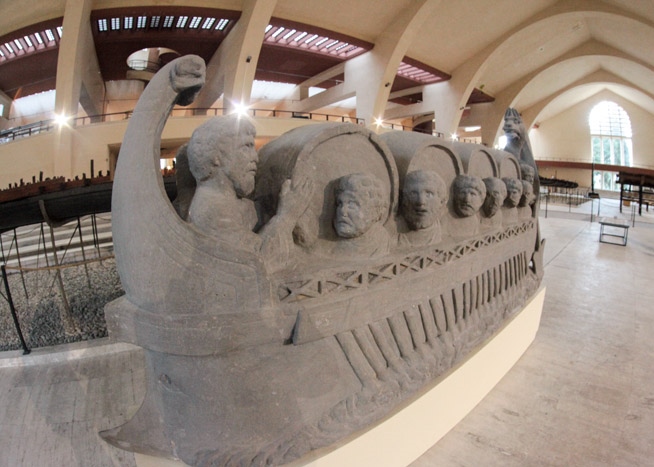
Nemi is a small volcanic lake in the surroundings of Rome, with a small village that climbs the slopes of Mount Artemisio which takes its name from the Temple of Diana, whose remains are right behind the village. It is not surprising that the ancient Romans wanted to build a temple in this site rich in centuries-old forests, lakes and delightful nature: still today it is easy to perceive an ancestral feeling, it is certainly a place where myth can be created.
Beyond myth, even ancient history has left its traces. In 1929 two ships of the time of the Emperor Caligula were found on the bottom of the lake and until 1931 a huge work of engineering was made to lower the level of the lake using waterworks, to allow the removal of ships that had a length of more than 70 meters.
Vittorio Ballio Morpurgo, one of the leading exponents of Italian rationalist architecture, was commissioned to design a museum to house the two enormous Roman ships, creating the first museum in Italy built according to its content. In 1939 the museum was finished, but in 1944 arson destroyed most of the ships and the museum.
Reopened in 1953 with models of ships 1:5, the museum closed in 1962 and finally reopened in 1988 but without adequate protection, heavy water infiltrations and many parts of the museum remained closed.
In May 2017 the museum finally completed its restoration, reopening all the areas of Morpurgo's project with its airy structure with wide arches of the ceiling that recall the ribs of a hull, and spiral staircases leading to the gallery overlooking the lake where the villa of Emperor Caligula also stood.
Two years ago the Guardia di Finanza recovered a statue of Caligula on the throne, and thanks to the testimonies of the tomb robbers arrested, brought to light a circular nymphaeum of about 30 meters in diameter. Other finds from the imperial villas of the area have been found in the last three years thanks to the excavation campaigns of the Montclair State University of New Jersey at the villa of the Antonini in Genzano.
All this and many other objects of enormous historical, artistic and archaeological value in the area will be exhibited in the museum, which is now fully operational.
But there's more. Last year in October the Carabinieri of cultural heritage found one of the mosaics that adorned the deck of one of the ships. A square adorned with very bright colors that form a floral decoration and that was in a private collection of an Italian lady who had long resided in New York.
The mosaic of serpentine and porphyry is particularly important for the reconstruction of the ornamental apparatus of ships, which according to experts had a function in religious ceremonies. The fragment is evidence of the magnificence of the bridge of command reserved to the emperor, who, in addition to the decorated floor, also had gold, enamel and bronze finishes, as well as marble elements.



